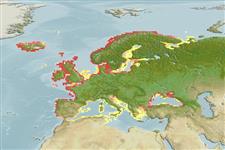Common names from other countries
Teleostei >
Salmoniformes (Salmons) >
Salmonidae (Salmonids) > Salmoninae
Etymology: Salmo: Latin, salmo, Plinius = salmon (Ref. 45335); trutta: trutta is a Latin name for trout (Ref. 10294).
More on author: Linnaeus.
Environment: milieu / climate zone / depth range / distribution range
生态学
海洋; 淡水; 半咸淡水; 溯河洄游 (Ref. 51243); 深度上下限 0 - 28 m (Ref. 101587), usually 1 - 2 m (Ref. 101587). 溫帶; 18°C - 24°C (Ref. 12741); 71°N - 34°N, 25°W - 57°E
Europe and Asia: Atlantic, North, White and Baltic Sea basins, from Spain to Chosha Bay (Russia). Found in Iceland and northernmost rivers of Great Britain and Scandinavia. In Rhône drainage, native only to Lake Geneva basin, which it entered after last glaciation. Native to upper Danube and Volga drainages. Introduced widely. Several countries report adverse ecological impact after introduction.
歐洲與亞洲: 歐洲的在西北部海岸.(參考文獻 51442) 在美國 (參考文獻 5723) 與澳洲各處廣泛地引入。 引入後的一些國家報告不利的生態衝擊。
Length at first maturity / 大小 / 重量 / 年龄
Maturity: Lm 40.9, range 1 - 600 cm
Max length : 140 cm SL 雄鱼/尚未辨别雌雄; (Ref. 682); common length : 72.0 cm TL 雄鱼/尚未辨别雌雄; (Ref. 3397); 最大体重: 50.0 kg (Ref. 682); 最大年龄: 38 年 (Ref. 32682)
背棘 (总数) : 3 - 4; 背的软条 (总数) : 10 - 15; 臀棘: 3 - 4; 臀鳍软条: 9 - 14; 脊椎骨: 57 - 59. Fusiform body (Ref. 51442). Head little and pointed (Ref. 51442). Mouth large, extending mostly after the eye and has well developed teeth (Ref. 51442). Teeth on shaft of vomer numerous and strongly developed (Ref. 7251). Caudal fin with 18-19 rays (Ref. 2196). Caudal peduncle thick and rounded (Ref. 51442). Little scales (Ref. 51442). Body is grey-blue colored with numerous spots, also below the lateral line (Ref. 51442). Blackish colored on upper part of body, usually orange on sides, surrounded by pale halos. Adipose fin with red margin.
纺锤型身体.(参考文献 51442) 头部小与尖的.(参考文献 51442) 嘴大的, 延伸在眼之后大部份而且有发展良好的齿.(参考文献 51442) 牙齿在犁骨的轴很多与发育明显的.(参考文献 7251) 尾鳍有 18-19个鳍条。 (参考文献 2196) 尾柄厚的而且圆的.(参考文献 51442) 小的鳞片.(参考文献 51442) 身体是灰色的-蓝色的彩色有很多的斑点, 也在侧线之下.(参考文献 51442) 在身体的上半部上的黑色的色彩, 通常橘色的在侧边上, 被灰白的晕圈包围了。 脂鳍有红色的边缘。
Found in streams, ponds, rivers and lakes (Ref. 5951). Individuals spend 1 to 5 years in fresh water and 6 months to 5 years in salt water (Ref. 51442). Juveniles mature in 3-4 years (Ref. 6885). Lacustrine populations undertake migration to tributaries and lake outlets to spawn, rarely spawning on stone, wave-washed lake shores. Spawns in rivers and streams with swift current, usually characterized by downward movement of water intro gravel (Ref. 59043). Spawning takes place normally more than one time (Ref. 51442). They prefer cold, well-oxygenated upland waters although their tolerance limits are lower than those of rainbow trout and favors large streams in the mountainous areas with adequate cover in the form of submerged rocks, undercut banks, and overhanging vegetation (Ref. 6465). Life history and spawning behavior is similar to the salmon Salmo salar (Ref. 51442). Each female produces about 10.000 eggs (Ref. 35388, Ref. 51442). Mainly diurnal (Ref. 682). Sea and lake trouts forage in pelagic and littoral habitats, while sea trouts mainly close to coast, not very far from estuary of natal river (Ref. 59043). Juveniles feed mainly on aquatic and terrestrial insects; adults on mollusks, crustaceans and small fish (Ref. 26523, Ref. 51442). Marketed fresh and smoked; eaten fried, broiled, boiled, cooked in microwave, and baked (Ref. 9988).
在淡水中度过 1 到 5 年与在咸水中 6个月到 5 年。 (参考文献 51442) 在 3-4 年中成熟。 (参考文献 6885) 它在河 (参考文献 30578) 中繁殖, 通常超过定时。 (参考文献 51442) 它偏爱寒冷,溶氧量高的丘陵地水域,虽然他们的包容限制是低于虹鳟的而且喜欢在多山的区域中的大溪流以足够的覆盖形成水下的岩石,堤岸下与上悬的植物.(参考文献 6465) 生活历史而且产卵行为是类似鲑鱼 Salmo salar.(参考文献 51442) 每个母鱼生产大约 10.000个卵。 (参考文献 35388, 参考文献 51442) 主要日行性.(参考文献 682) 稚鱼主要捕食水生与陆栖的昆虫; 成鱼捕食软件动物,甲壳动物与小鱼。 (参考文献 26523, 参考文献 51442) 在市场上销售熏制或新鲜了; 油炸后食用, 火烤,煮沸,在微波煮了, 而且烧烤了。 (参考文献 9988)
Female covers the eggs by restirring the sand and fine gravel (Ref. 9696). After hatching at 12 mm, larval brown trout remain in the gravel for 2-3 weeks until they are about 25 mm long, when they emerge to begin feeding in the water column. Brown trout are territorial and begin establishing territories as juveniles. Juvenile trout from lake populations move from their natal inlets to lakes during the first 2 years of life (Ref. 6390).歐洲與亞洲: 歐洲的在西北部海岸.(參考文獻 51442) 在美國 (參考文獻 5723) 與澳洲各處廣泛地引入。 引入後的一些國家報告不利的生態衝擊。
Svetovidov, A.N., 1984. Salmonidae. p. 373-385. In P.J.P. Whitehead, M.-L. Bauchot, J.-C. Hureau, J. Nielsen and E. Tortonese (eds.) Fishes of the north-eastern Atlantic and the Mediterranean. UNESCO, Paris. vol. 1. (Ref. 4779)
CITES (Ref. 128078)
Not Evaluated
人类利用
渔业: 商业性; 养殖: 商业性; 游钓鱼种: 是的
工具
特别资料
下载 XML
网络资源
Estimates based on models
Preferred temperature (Ref.
115969): 6.5 - 15.8, mean 10.1 (based on 918 cells).
Phylogenetic diversity index (Ref.
82804): PD
50 = 0.5000 [Uniqueness, from 0.5 = low to 2.0 = high].
Bayesian length-weight: a=0.00851 (0.00755 - 0.00960), b=3.03 (3.00 - 3.06), in cm Total Length, based on LWR estimates for this species (Ref.
93245).
营养阶层 (Ref.
69278): 3.4 ±0.1 se; based on diet studies.
回复力 (Ref.
120179): 中等的, 族群倍增时间最少 1.4 - 4.4年 (rm=0.9; K=0.09-0.8; tmax=8; Fec=1,000).
Prior r = 0.46, 95% CL = 0.30 - 0.68, Based on 1 data-limited stock assessment.
Fishing Vulnerability (Ref.
59153): High vulnerability (60 of 100).
Climate Vulnerability (Ref.
125649): Very high vulnerability (85 of 100).
